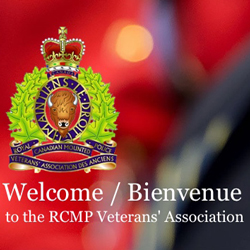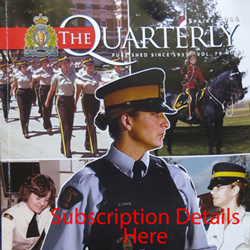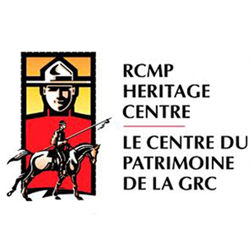RCMP: Background On Issued Sam Browne

Recently, we received the following question from David Colitis:
I recently came across a question dated January 2015 regarding Sam Browne belts and the wearing of them – namely, should the strap be over the right or the left shoulder.
I was a commissioned officer in the Canadian Army in the 1960s, and Sam Brownes were part of the uniform. We wore them with the strap over the right shoulder. In my regiment (and maybe others as well) regimental sergeants-major wore Sam Brownes as well, also with the strap over the same shoulder – the right.
The reason the straps were on the right shoulder was because swords are worn on the left, but drawn by and held in the right hand. The strap supports the extra weight of the sword. Regimental sergeants major were also entitled to carry a sword.
Perhaps that is the answer to the question – those carrying or entitled to carry a sword wear the Sam Browne with a strap over the right shoulder.
Based on this enquiry, Veteran Ric Hall provided the following response:

Photograph of the RCMP Red Serge for a Sergeant Major with a holster and shoulder strip on the opposite side of the Sam Browne belt (Source of photo – Ric Hall’s Photo Collection).
You are right about the cross strap for officers and Sergeants Major coming across from the right shoulder to the left side for the purposes of carrying the sword for ceremonial duties. For years regular members of the force the cross strap was reversed due to the revolver being carried on the right side. The Force did not acknowledged that some people were actually left handed and made us all carry and shoot right handed. Today members are allowed to wear (and shoot) right or left handed holsters….so for the lefties the cross strap is from the right shoulder to left hip and holster. Which does not make for uniformity when members are on parade in Review Order (Red Serge). But that is today’s RCMP. Attached is a picture of a Sgt. Major from the 1930s wearing a holster and a sword. That order of dress is still in effect today for officers and Sergeants Major. At one point in time officers wore two cross straps, two vertically see Sam Steele picture and two crossing each other.
I have included below some supplementary details for you:
JUN 1904 – Over the history of the Force members have spent countless hours polishing their “Sam Browne” to a high gloss. Originally fitted with brass fittings that had to polished, many a member had their brass electro-plated to avoid constantly shining the brass. Those days are long gone as the brass fitting now are coated to prevent the “green” look of un-shone brass. Many, also had “hooks” installed on the belt, similar to the modern day Sam Browne, to avoid the polish from cracking when doing up the belt. Where did the “Sam Browne” come from?
During the Indian Mutiny of 1857-58, an unknown native warrior slashed off a British officer’s left arm during a skirmish, unknowingly he created the condition that led to the invention of the most famous belt in the world – the Sam Browne.

Photograph of General Sir Sam Browne.
The polished Sam Browne was a symbol of authority and a mark of military sartorial splendor for generations of British, Dominion and colonial officers. Captain Samuel Brown after losing his arm in hand-to-hand fighting at Seerporah in 1858, he was awarded the Victoria Cross, Britain’s highest award for valour, for his actions, found it impossible to carry his sword, so he devised a leather harness to hold the sword in place and support its weight at his side. The Sam Browne belt was born. During WWI officers led the charge wearing their Sam Browne and flashing their swords making them easy targets for enemy snipers…..trench warfare soon but an end to this, more practical webbing came into being. Officers in the rear ranks still continued to wear the Sam Browne. In September 1939, at the start of WWII the Canadian military abolished the Sam Browne. Soon officers in England were asking for their Sam Browne to be sent overseas, as they were required to carry a revolver while stationed in England, fearing a German invasion.
The Sam Browne had been unofficially worn off and on for years by NWMP and RNWMP officers and members in the field, buying them at their own expense, using the Canadian Militia pattern. Order-in-Council of June 22, 1904 ratified the Sam Browne equipment. The belts were to be issued free to officers on appointment and were to be returned upon retirement. This allowed officers to carry a sword and a revolver in a covered holster. A General Order of October 09, 1905 required all officers on mounted parade or prairie duty to carry a cavalry whistle. The matter of the other ranks’ pattern was resolved in 1905. The Sam Browne issued to officers and member’s remains basically the same to this day.Be
General Sir Sam Browne VC, GCB, KCSI retired from the army in 1898, relocated to Ryde on the Isle of Wight and died there at the age of 74. His remains were cremated but there is a memorial marker dedicated to Browne in the Ryde town cemetery, as well as plaques at St Paul’s Cathedral and Lahore Cathedral.
Dave provided the following response:
Incidentally, you note that the Canadian military abolished the Sam Browne in 1939, yet when I served in the 1960’s we wore Sam Browne’s with two of our uniforms – the winter serge (our number 4’s) and the summer TWs (our number 5’s), and would have used a leather frog should we had to carry our swords. We also had gold sword slings to carry swords if were wore our blues (our number 1’s).

Photograph of retired RCMP Superintendent Ric Hall (Source of the photo – Ric Hall’s Photo Collection).


 September 29, 2016
September 29, 2016 






